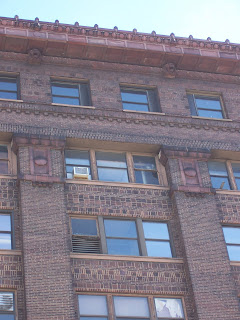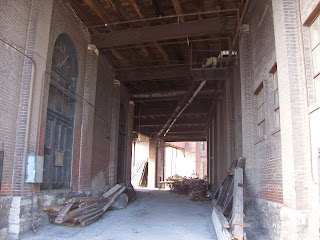One of my favorite neighborhoods in the city is Benton Park, an area just west of I-55 from the more well known Soulard neighborhood. Benton Park is a beautiful part of town, and not really because it has dozens of mansions. Rather, it is a compilation of simple and elegant houses that work together to create some of the most intact and urban streetscapes in the city. Here is a
bird's eye view of the neighborhood. Below is a typical house in the area, that is set back far from the street; I suspect that it was originally meant to be an alley house.

Below are two great examples of houses that were clearly built at the same time, and show evidence that they are now being carefully restored simultaneously as well. I love Mansard roofs.

Here is a house that is three stories tall next door; personally I think two story houses work better with Mansard roofs from a proportion standpoint.

Below is a storefront that features apartments above; it would be perfect for a small, but classy, convenience store or coffee shop.

The streetscape below illustrates well how each building is an integral part of a greater architectural "canvas." The four houses on the left appear to have been built speculatively at the same time. The rest are also very well preserved.

This house, next to the four siblings, is a one-off design that looks well restored.

Modern accoutrements, including a satellite dish, show how these 100 year old houses can still adapt to modern usage and habitation.

Below is a type of rowhouse that is not very common in St. Louis: the three houses are essentially one big building that is made to look like three houses.

I love the little one story rowhouses like the one below; the classical, Italianate cornice makes the little shotgun house distinct.

Here is an apartment building or condo conversion, supplying the neighborhood with a variety of housing sizes and prices (though they are increasingly rising in the neighborhood).

Below is an example of a more elaborate house sitting on the south side of Benton Park itself. The rounded windows, now nightmares for the modern restorer, were once very common in the houses of the middle class in the city.

Even though I grew up in St. Louis, I had never even heard of Benton Park until about 2004. To be fair, if I-55 hadn't been built, we would probably just call it west Soulard. Crime seems low in the neighborhood, and there is great access to the rest of the city. Benton Park stands as the model for the rehabbing of nearby neighborhoods such as Dutchtown or Benton Park West.
 The building alternates tan brick for the exterior walls with stone decorative elements such as the giant Ionic pilasters on the front of the building.
The building alternates tan brick for the exterior walls with stone decorative elements such as the giant Ionic pilasters on the front of the building. Even the roof looks more fitting for an English country house than for a power plant. The round window is transformed into a cartouche with elaborate filligry.
Even the roof looks more fitting for an English country house than for a power plant. The round window is transformed into a cartouche with elaborate filligry. I would love to be able to see the interior of this building; perhaps some of the ornate decoration of the exterior continues inside. Check out a bird's eye view here. If you look closely, you can see how a rail line once passed by the front of the building, causing a small triangular setback of the front facade.
I would love to be able to see the interior of this building; perhaps some of the ornate decoration of the exterior continues inside. Check out a bird's eye view here. If you look closely, you can see how a rail line once passed by the front of the building, causing a small triangular setback of the front facade.





























































